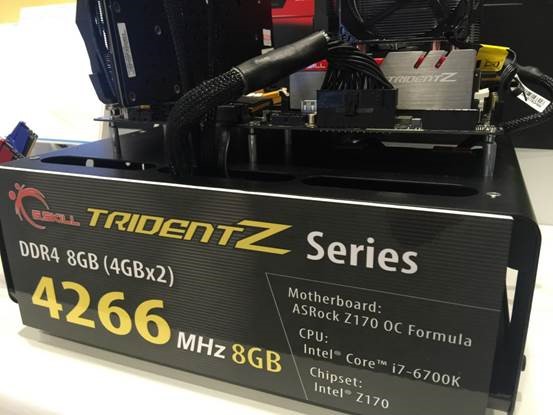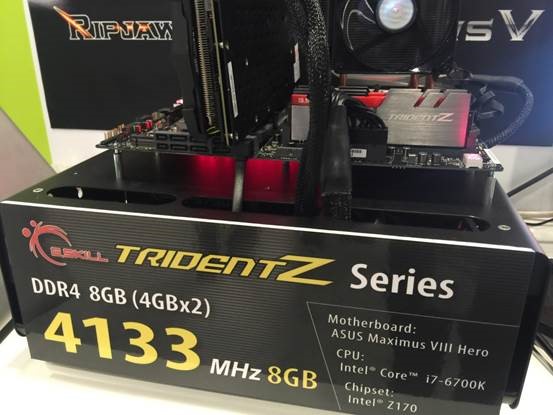G.Skill Shows Off Two New DDR4 RAM Kits Clocked At Over 4000 MHz
Along with Intel's Skylake processors comes a shift to DDR4 RAM. Although DDR4 was previously used on some high-end systems and servers, most systems today continue to use DDR3. As this changes, the need for high-performance DDR4 increases, which leads companies like G.Skill to release products like the ones announced today: two new DDR4 kits running at over 4000 MHz.
The new top-end kit from G.Skill runs at an aggregate 4266 MHz, with timings of 19-25-25-45 CR2. The second kit announced is only slightly slower, pushing 4133 MHz while maintaining the same timings.
"We are truly excited to demo such extremely high memory speed on live demo systems, since DDR4 4000+MHz speeds were traditionally only achievable under extreme overclocking on liquid nitrogen cooling," says Frank Hung, Product Marketing at G.Skill. "We see amazing performance potential for the new DDR4 memory technology on the newest Intel platform, and very excited to see where it will take us in the near future."
It is impressive to see that DDR4 has come such a long way in a relatively short amount of time. Only a few months ago overclockers would need to utilize extreme cooling solutions in order to achieve a clock speed over 4000 MHz, but now these air cooled kits do it with ease.
It is likely that the RAM technology itself has significantly improved to accomplish this, but Skylake may have something to do with it, too. The memory controller inside of the processor has a lot to do with maintaining stability, and it is likely that the improvements Intel made in its DDR4 controller helped it cope with memory running at such fast speeds.
A small problem with this RAM is that G.Skill currently plans to sell it in 2 x 4 GB kits. To be fair, a lot of memory kits sell in this configuration right now, but enthusiasts looking to buy a high-end memory kit like this often want 16 GB of memory or more. As a result, G.Skill should really consider releasing a 4 x 4 GB kit in the future.
Currently, there is no price or release date set for either kit announced. Both kits are being demoed at IDF 2015, taking place this week in San Francisco.
Get Tom's Hardware's best news and in-depth reviews, straight to your inbox.
Follow Michael Justin Allen Sexton @LordLao74. Follow us @tomshardware, on Facebook and on Google+.
-
Rookie_MIB Unfortunately with those CAS timings they're really no better than 2133 CAS 9 DDR3..Reply
4266/CAS19 = 217
2133/CAS9 = 237 which means more operations/second -
IInuyasha74 Reply16488075 said:Unfortunately with those CAS timings they're really no better than 2133 CAS 9 DDR3..
4266/CAS19 = 217
2133/CAS9 = 237 which means more operations/second
It is still improvement though. The bandwidth is much greater 68,256 MB/s vs 34,128 MB/s. The access time is a little slower than than a DDR3 2133/CAS9 kit, 8.9ns for the 4266 MHz kit vs 8.4ns for the DDR3, but you are transferring twice the amount of data each time. The end result is that the DDR3 kit mentioned here would achieve 18 cycles in the time it takes the DDR4 kit here to complete 17 cycles. The DDR4 is still better, however, because in 17 cycles it will provide 1,160,352 MB/s of bandwidth, while the DDR3 only provides 614,304. -
darkokills I'm sitting pretty with 2400Mhz DDR3 and will be for a while. Don't need anything more than my 4790k for now.Reply -
Rookie_MIB Reply16488075 said:Unfortunately with those CAS timings they're really no better than 2133 CAS 9 DDR3..
4266/CAS19 = 217
2133/CAS9 = 237 which means more operations/second
It is still improvement though. The bandwidth is much greater 68,256 MB/s vs 34,128 MB/s. The access time is a little slower than than a DDR3 2133/CAS9 kit, 8.9ns for the 4266 MHz kit vs 8.4ns for the DDR3, but you are transferring twice the amount of data each time. The end result is that the DDR3 kit mentioned here would achieve 18 cycles in the time it takes the DDR4 kit here to complete 17 cycles. The DDR4 is still better, however, because in 17 cycles it will provide 1,160,352 MB/s of bandwidth, while the DDR3 only provides 614,304.
Well, that's only true if the memory controller is a quad channel controller as in Ivy Bridge-E or Haswell-E. For those moving to Skylake, that only has a dual channel memory controller and as such will only be operating at the same relative speeds as mainstream Haswell products. And because this particular kit is ONLY a 2x4GB kit, it cannot achieve those speeds that you mention.
-
IInuyasha74 Reply16488578 said:16488075 said:Unfortunately with those CAS timings they're really no better than 2133 CAS 9 DDR3..
4266/CAS19 = 217
2133/CAS9 = 237 which means more operations/second
It is still improvement though. The bandwidth is much greater 68,256 MB/s vs 34,128 MB/s. The access time is a little slower than than a DDR3 2133/CAS9 kit, 8.9ns for the 4266 MHz kit vs 8.4ns for the DDR3, but you are transferring twice the amount of data each time. The end result is that the DDR3 kit mentioned here would achieve 18 cycles in the time it takes the DDR4 kit here to complete 17 cycles. The DDR4 is still better, however, because in 17 cycles it will provide 1,160,352 MB/s of bandwidth, while the DDR3 only provides 614,304.
Well, that's only true if the memory controller is a quad channel controller as in Ivy Bridge-E or Haswell-E. For those moving to Skylake, that only has a dual channel memory controller and as such will only be operating at the same relative speeds as mainstream Haswell products. And because this particular kit is ONLY a 2x4GB kit, it cannot achieve those speeds that you mention.
No. First, Ivy Bridge-E can only use DDR3 memory, not DDR4. Second, the calculations I did were assuming the use of a dual-channel memory controller.
Bandwidth = Memory clock speed x data width / 8
so
68,256 = 4266 x 128 / 8 Or more simply 68,256 = 4266 x 16
If it was using a quad-channel memory interface like Haswell-E then it would again double the total bandwidth again. In that case you are right you would need a second kit, or a 4 x 4 GB kit at least. -
Joe Black It's likely got something to do with the processor (as in it supports it), but mostly with the manufacturing tech that leaks less current and generates less heat. Let's be realistic here.Reply -
Jerahmia Wood Im not really impressed, its well proven (especially by maximum PC) that memory speed has diminishing returns and little performance increase even with modern software with the acception of using on-die GPUs and APUs (witch for the forseeable future will not rival the performance of a discreet lower-mid to high end GPU) memory speed matters little above DDR3-1600 speeds, id rather spend the money on higher capacity cheaper kits, and put that money saved toward a faster GPU, CPU or SSD where it really matters.Reply -
gilbadon I love how CPU's changed to GHz as soon as they hit 1, but memory is like "screw it, our number looks bigger anyway" even though they are breaking 4.Reply -
mapesdhs I'd much rather they just yank the prices down on the higher capacity, upper end DDR3 kits. There's no reason for a 32GB/2400 kit to continue to be so expensive.Reply
Meanwhile, the 8GB and 16GB kits should drop too. Only this week have I finally seen an 8GB/2133 kit for the same low price that they reached several years ago before everything went through the roof (blamed of course of floods & supplier factory-damage, but that was never a satisfactory explanation for all of the price rises; much of it was just price gouging because they could IMO).
-
mapesdhs Jerahmia, that's too much of a generalisation. Some apps very much do benefit from faster RAM speeds, eg. After Effects. Friend of mine tested his 3930K/4.7 system with 2133 vs. 2400, render times increased several percent with the lower speed.Reply
For consumer apps though, yes indeed, a lot of programs don't gain much. Games vary, but generally also not affected much. However, supply/demand issues often mean that the pricing sweet spot for DDR3 is around the 2133 speed anyway, ie. buying a slower kit is often more expensive. That was certainly the case when I bought my 16GB 2400 kit, it was cheaper than the 2133 kit.


